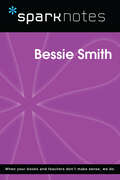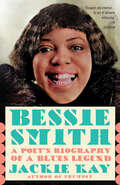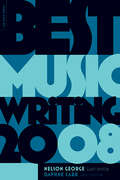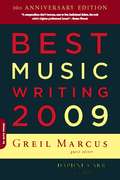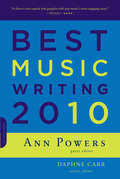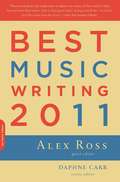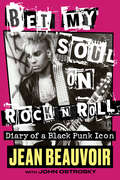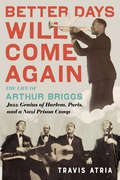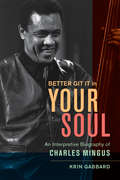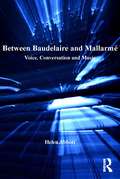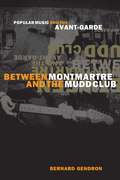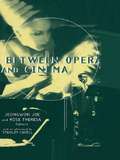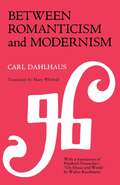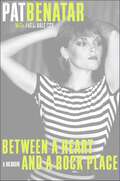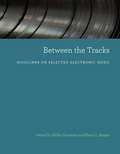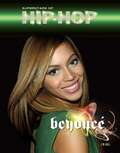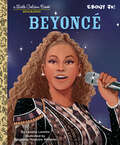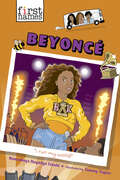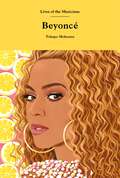- Table View
- List View
Bessie Smith (SparkNotes Biography Guide)
by SparkNotesBessie Smith (SparkNotes Biography Guide) Making the reading experience fun! SparkNotes Biography Guides examine the lives of historical luminaries, from Alexander the Great to Virginia Woolf. Each biography guide includes:An examination of the historical context in which the person lived A summary of the person&’s life and achievements A glossary of important terms, people, and events An in-depth look at the key epochs in the person&’s career Study questions and essay topics A review test Suggestions for further reading Whether you&’re a student of history or just a student cramming for a history exam, SparkNotes Biography guides are a reliable, thorough, and readable resource.
Bessie Smith: A Poet's Biography of a Blues Legend
by Jackie KayA beautiful genre-bending tribute to the larger-than-life blues singer Bessie Smith. Scotland&’s National Poet blends poetry, prose, fiction, and nonfiction to create an entirely unique biography of the Empress of the Blues.There has never been anyone else like Bessie Smith. Born in Chattanooga, Tennessee, in 1894 and orphaned by the age of nine, Bessie Smith sang on street corners before becoming a big name in traveling shows. In 1923, she made her first recording for the newly founded Columbia Records. It sold 780,000 copies and catapulted her to fame. Known for her unmatched vocal talent, her timeless and personal blues narratives, her tough persona, and her ability to enrapture audiences with her raw voice, the Empress of the Blues remains a force and an enigma. In this remarkable book, Kay combines history and personal narrative, poetry and prose to create an enthralling account of an extraordinary life, and to capture the soul of the woman she first identified with as a young Black girl growing up in Glasgow. Powerful and moving, Bessie Smith is at once a vivid biography of a central figure in American music history and a personal story about one woman&’s search for recognition. A VINTAGE ORIGINAL.
Best Music Writing 2008
by Nelson George Daphne CarrThe ninth entry in the acclaimed series celebrating the best writing on every style of music, from rock to hip-hop, R&B to jazz, pop to blues, and more. aa"
Best Music Writing 2009
by Greil MarcusLegendary critic Greil Marcus takes the helm for the landmark tenth edition of Da CapoOCOs annual compendium of the best in music writing"
Best Music Writing 2010
by Ann Powers Daphne CarrBest Music Writing has become one of the most eagerly awaited annuals out there. Celebrating the year in music writing by gathering a rich array of essays, missives, and musings on every style of music from rock to hip-hop to R&B to jazz to pop to blues and more, it is essential reading for anyone who loves great music and accomplished writing. Scribes of every imaginable sort-novelists, poets, journalists, musicians-are gathered to create a multi-voiced snapshot of the year in music writing that, like the music it illuminates, is every bit as thrilling as it is riveting.
Best Music Writing 2011
by Alex Ross Daphne CarrTwelfth in the acclaimed series of annual collections celebrating the best writing on every style of music, from rock to hip-hop, R&B to jazz, pop to blues, and more
Best. Night. Ever.: A Story Told from Seven Points of View
by Alison Cherry Stephanie Faris Rachele Alpine Jen Malone Gail Nall Ronni Arno Dee RomitoLove Actually meets Adventures in Babysitting in this hilarious novel written by seven authors about seven classmates who are preparing for a crazy night at their middle school dance.Lynnfield Middle School is prepped and ready for a dance to remember, including an awesome performance from Heart Grenade, the all-girl band who recently won a Battle of the Bands contest. Seven classmates—Carmen, Genevieve, Tess, Ryan, Ellie, Ashlyn, and Jade—intend to make the most of the night…or at least the five of them who are able to attend do. The other two would sacrifice almost anything to be there. One thing’s for sure—this entire crew is in for one epic night! Gail Nall, Dee Romito, Rachele Alpine, Ronni Arno, Alison Cherry, Stephanie Faris, and Jen Malone have created a charming, hilarious, and relatable novel that’s perfect for anyone who can’t wait to dance the night away.
Bet My Soul on Rock 'n' Roll: Diary of a Black Punk Icon
by John Ostrosky Jean BeauvoirThe life and career of Haitian American musician Jean Beauvoir, a member of the legendary New York City punk band the Plasmatics Jean Beauvoir joined the Plasmatics in 1979, playing bass and keyboards for the most notorious band to emerge out of the New York City punk scene. By 1982, he was a member of Little Steven and the Disciples of Soul, a retro-rock revival act headed by Steven Van Zandt. The Disciples of Soul videos played on MTV during the network's earliest years, making Beauvoir one of the first Black recording artists to cross the start-up music channel's "color line." Beauvoir went on to become a multi-platinum artist, producer, and songwriter. Bet My Soul on Rock 'n' Roll follows his ride through the American music industry, detailing his encounters with rock stars such as Bruce Springsteen, Paul Stanley, Gene Simmons, and Lita Ford, as well as the actor Sylvester Stallone, the billionaire executive Richard Branson, and even Donald Trump. Beauvoir also considers the manner in which his Haitian heritage has shaped his public image, his music, and his role as an activist for the dispossessed and the poor. Beauvoir's collaborations—and stories—span genres, including work with KISS, Debbie Harry, Justin Timberlake, Lionel Richie, and the Ramones
Better Days Will Come Again: The Life of Arthur Briggs, Jazz Genius of Harlem, Paris, and a Nazi Prison Camp
by Travis AtriaArthur Briggs's life was Homeric in scope. Born on the the tiny island of Grenada, he set sail for Harlem during the Renaissance, then to Europe in the aftermath of WWI, where he was among the first pioneers to introduce jazz music to the world. During the legendary Jazz Age in Paris, Briggs's trumpet provided the soundtrack while Hemingway, Fitzgerald, and the rest of the Lost Generation got drunk. By the 1930s, Briggs was considered "the Louis Armstrong of Paris," and was the peer of the greatest names of his time, from Josephine Baker to Django Reinhardt. Even during the Great Depression, he was secure as "the greatest trumpeter in Europe." He did not, however, heed warnings to leave Paris before it fell to the Nazis, and in 1940, he was arrested and sent to the prison camp at Saint Denis. What happened at that camp, and the role Briggs played in it, is truly unforgettable. Better Days Will Come Again, based on groundbreaking research and including unprecedented access to Briggs's oral memoir, is a crucial document of jazz history, a fast-paced epic, and an entirely original tale of survival.
Better Git It in Your Soul
by Krin GabbardCharles Mingus is one of the most important--and most mythologized--composers and performers in jazz history. Classically trained and of mixed race, he was an outspoken innovator as well as a bandleader, composer, producer, and record-label owner. His vivid autobiography, Beneath the Underdog, has done much to shape the image of Mingus as something of a wild man: idiosyncratic musical genius with a penchant for skirt-chasing and violent outbursts. But, as the autobiography reveals, he was also a hopeless romantic. After exploring the most important events in Mingus's life, Krin Gabbard takes a careful look at Mingus as a writer as well as a composer and musician. He digs into how and why Mingus chose to do so much self-analysis, how he worked to craft his racial identity in a world that saw him simply as "black," and how his mental and physical health problems shaped his career. Gabbard sets aside the myth-making and convincingly argues that Charles Mingus created a unique language of emotions--and not just in music. Capturing many essential moments in jazz history anew, Better Git It in Your Soul will fascinate anyone who cares about jazz, African American history, and the artist's life.
Between Baudelaire and Mallarmé: Voice, Conversation and Music
by Helen AbbottAs the status of poetry became less and less certain over the course of the nineteenth century, poets such as Baudelaire and Mallarmé began to explore ways to ensure that poetry would not be overtaken by music in the hierarchy of the arts. Helen Abbott examines the verse and prose poetry of these two important poets, together with their critical writings, to address how their attitudes towards the performance practice of poetry influenced the future of both poetry and music. Central to her analysis is the issue of 'voice', a term that remains elusive in spite of its broad application. Acknowledging that voice can be physical, textual and symbolic, Abbott explores the meaning of voice in terms of four categories: (1) rhetoric, specifically the rules governing the deployment of voice in poetry; (2) the human body and its effect on how voice is used in poetry; (3) exchange, that is, the way voices either interact or fail to interact; and (4) music, specifically the question of whether poetry should be sung. Abbott shows how Baudelaire and Mallarmé exploit the complexity and instability of the notion of voice to propose a new aesthetic that situates poetry between conversation and music. Voice thus becomes an important process of interaction and exchange rather than something stable or static; the implications of this for Baudelaire and Mallarmé are profoundly significant, since it maps out the possible future of poetry.
Between Composers: The Letters of Norma Beecroft and Harry Somers
by Brian CherneyIn the fall of 1959 Norma Beecroft, a twenty-five-year-old composition student, left her home in Toronto and travelled to Rome to study with the eminent Italian composer Goffredo Petrassi. She left behind her lover and mentor, the thirty-four-year-old Harry Somers, by then recognized as one of Canada’s leading young composers. For the next six months they wrote each other almost every day. Their intense and intimate correspondence documents lives lived apart but shared on the page, until the relationship came to an abrupt end.Selected from the full extant correspondence, the letters show both composers at pivotal moments in their careers, processing music and culture in their respective environments in ways that would remain influential for themselves and to each other. Beyond illuminating a tempestuous love affair, their wide-ranging letters capture the development of Canadian arts and culture of the period. They record observations about significant figures in their circles; the performances, theatre, and art Somers experienced in Toronto; and Beecroft’s attempts to forge a viable compositional approach through contact with important artists and composers abroad. Somers eventually realized that what he wanted most was for Beecroft to give up her studies and return to Toronto to marry him. She turned him down and remained in Italy to study and write music, cementing her commitment to the vocation that would shape the rest of her creative life. She would break ground as a woman in her field, a producer for the CBC, and a composer and early champion of electroacoustic music.A window into cultural life in Canada and Rome at the end of the 1950s, Between Composers is a striking record of a turning point in the lives and careers of two young artists that would mark them and their music for decades.
Between Montmartre and the Mudd Club: Popular Music and the Avant-Garde
by Bernard GendronDuring the late nineteenth and early twentieth century, popular music was considered nothing but vulgar entertainment. Today, jazz and rock music are seen as forms of art, and their practitioners are regularly accorded a status on par with the cultural and political elite. To take just one recent example, Bono, lead singer and lyricist of the rock band U2, got equal and sometimes higher billing than Pope John Paul II on their shared efforts in the Jubilee 2000 debt-relief project. When and how did popular music earn so much cultural capital? To find out, Bernard Gendron investigates five key historical moments when popular music and avant-garde art transgressed the rigid boundaries separating high and low culture to form friendly alliances. He begins at the end of the nineteenth century in Paris's Montmartre district, where cabarets showcased popular music alongside poetry readings in spaces decorated with modernist art works. Two decades later, Parisian poets and musicians "slumming" in jazz clubs assimilated jazz's aesthetics in their performances and compositions. In the bebop revolution in mid-1940s America, jazz returned the compliment by absorbing modernist devices and postures, in effect transforming itself into an avant-garde art form. Mid-1960s rock music, under the leadership of the Beatles, went from being reviled as vulgar music to being acclaimed as a cutting-edge art form. Finally, Gendron takes us to the Mudd Club in the late 1970s, where New York punk and new wave rockers were setting the aesthetic agenda for a new generation of artists. Between Montmartre and the Mudd Club should be on the shelves of anyone interested in the intersections between high and low culture, art and music, or history and aesthetics.
Between Montmartre and the Mudd Club: Popular Music and the Avant-Garde
by Bernard GendronDuring the late nineteenth and early twentieth century, popular music was considered nothing but vulgar entertainment. Today, jazz and rock music are seen as forms of art, and their practitioners are regularly accorded a status on par with the cultural and political elite. To take just one recent example, Bono, lead singer and lyricist of the rock band U2, got equal and sometimes higher billing than Pope John Paul II on their shared efforts in the Jubilee 2000 debt-relief project. When and how did popular music earn so much cultural capital? To find out, Bernard Gendron investigates five key historical moments when popular music and avant-garde art transgressed the rigid boundaries separating high and low culture to form friendly alliances. He begins at the end of the nineteenth century in Paris's Montmartre district, where cabarets showcased popular music alongside poetry readings in spaces decorated with modernist art works. Two decades later, Parisian poets and musicians "slumming" in jazz clubs assimilated jazz's aesthetics in their performances and compositions. In the bebop revolution in mid-1940s America, jazz returned the compliment by absorbing modernist devices and postures, in effect transforming itself into an avant-garde art form. Mid-1960s rock music, under the leadership of the Beatles, went from being reviled as vulgar music to being acclaimed as a cutting-edge art form. Finally, Gendron takes us to the Mudd Club in the late 1970s, where New York punk and new wave rockers were setting the aesthetic agenda for a new generation of artists.Between Montmartre and the Mudd Club should be on the shelves of anyone interested in the intersections between high and low culture, art and music, or history and aesthetics.
Between Opera and Cinema (Critical and Cultural Musicology)
by Jeongwon Joe Rose TheresaLeading scholars of opera and film explore the many ways these two seemingly unrelated genres have come together from the silent-film era to today.
Between Romanticism and Modernism: Four Studies in the Music of the Later Nineteenth Century (California Studies in 19th-Century Music #1)
by Carl DahlhausCarl Dahlhaus here treats Nietzsche's youthful analysis of the contradictions in Wagner's doctrine (and, more generally, in romantic musical aesthetics); the question of periodicization in romantic and neo-romantic music; the underlying kinship between Brahms's and Wagner's responses to the central musical problems of their time; and the true significance of musical nationalism. Included in this volume is Walter Kauffman's translation of the previously unpublished fragment, "On Music and Words," by the young Nietzsche.
Between a Heart and a Rock Place: A Memoir
by Patsi Bale Cox Pat BenatarGrammy winner Pat Benatar recounts her career as a rock icon and “tells her story with heartfelt honesty” in this New York Times–bestselling memoir (Deseret News).One of the best-selling female rock stars of all time, the incomparable Pat Benatar writes about her Long Island childhood, her experiences in the record industry, and how her generation changed music forever in this “engaging” autobiography (Slate). The first solo female rocker ever to appear on MTV, Benatar writes with the same edge and attitude that was a hallmark of her music—from “Heartbreaker” to “Hit Me with Your Best Shot.” The winner of four consecutive Grammy Awards for Best Female Rock performance, Benatar tells a fascinating, no-holds-barred story of what it was really like to be a woman in the mostly male world of hard rock in the ’80s.Includes photos
Between the Tracks: Musicians on Selected Electronic Music
by Miller Puckette Kerry L. HaganA collection that goes beyond the canon to analyze influential yet under-examined works of electronic music.This collection of writings on electronic music goes outside the canon to analyze influential works by under-recognized musicians. The contributors, many of whom are composers and performers themselves, offer their unsung musical heroes the sort of in-depth examinations usually reserved for more well-known composers and works. They analyze music from around the world and across genders, race, nationality, and age, discussing works that range from soundscapes of rushing water and resonating pipes to compositions by algorithm.
Beware, the Cows Are Coming!
by Rachakonda Viswanatha Sastri M. Sridhar Alladi UmaSet between the Bolshevik Revolution and the independence of India, the novella tells the story of an ordinary woman's rebellion against her sexual exploitation by a landlord and the injustice done to her son.
Beyonce (Superstars of Hip-Hop)
by Z. B. HillBeyonce Knowles is one of the most famous women in the world. The singing superstar has become one of the biggest artists in music since making her start with the group Destiny's Child years ago. Beyonce has sold millions of albums and won many awards in her career. And now she's married to rapper Jay-Z and has a new daughter, Blue Ivy. It seems Beyonce has it all! Beyonce tells the story of how one girl from Texas grew up to be an international star. Read about Beyonce's rise to fame from her days in Destiny's Child to her hit solo albums. Learn what it takes to be one of the world's biggest celebrities.
Beyonce: A Little Golden Book Biography (Little Golden Book)
by Lavaille LavetteCreated in partnership with Ebony Jr., this captivating Little Golden Book biography celebrates Beyoncé's rise from a shy little girl to a world-famous superstar.Beyoncé Giselle Knowles-Carter is an American singer, songwriter, and actress. Born and raised in Houston, Texas, Beyoncé performed in various singing and dancing competitions as a child. She rose to fame in the late 1990s as the lead singer of Destiny's Child, one of the best-selling girl groups of all time. Beyoncé continues to inspire and demonstrate that dreams—no matter how big—can be achieved through hard work and determination. Michelle Obama has called her a "role model for us all." Since 1945, Ebony magazine has shined a spotlight on the worlds of Black people in America and worldwide, telling their stories. Ebony Jr! was created in 1973 to give Black children a magazine that was all their own. The magazine included stories, comics, puzzles, and cartoons centering Black children. Its mission was to ignite a love of reading and a love of self in Black kids, and we&’re continuing that with our branded LGB program.
Beyonce: Singer-songwriter, Actress, and Record Producer
by Chuck BednarFrom the earliest moments of her childhood in Houston, Texas, it was clear that Beyoncé, of mixed African-American and Louisiana Creole descent, had a special gift when it came to performing in front of a crowd. At the age of seven, she dominated much older kids in a local talent show, and appeared on national television before she was even a teenager. She went on to become a part of the super group Destiny's Child and was one of the key reasons they eventually became one of the most popular female musical groups of all time. The road to success wasn't always easy, however, as Beyoncé managed to overcome many obstacles on the road to superstardom, and go on to find both success and happiness in her professional and private lives. Beyoncé is a multiple Grammy-award winning superstar, an incredibly talented and successful singer-songwriter, an accomplished actress, and a successful businesswoman. In short, Beyoncé is an extraordinary achiever.
Beyoncé (First Names)
by Nansubuga Nagadya IsdahlMeet the woman who changed music forever and showed that girls can run the world! Before she was an international superstar and feminist icon, Beyoncé was a girl from Texas who loved to sing and dance. As a member of Destiny’s Child, she climbed the charts and became a member of one of the most famous girl groups in history. This launched Beyoncé into her solo career, and since then, she’s become an unstoppable force in music and pop culture. Beyond music, she is a successful businesswoman and activist who helps bring issues of race and gender into the global conversation. Empowering and inspirational, Beyoncé tells the story of the woman who showed that girls can run the world. It includes a timeline, glossary, and index. First Names is a highly illustrated nonfiction series that puts readers on a first-name basis with some of the most incredible people in history and of today!
Beyoncé (Lives of the Musicians)
by Tshepo MokoenaBeyoncé is not simply a pop sensation. She is a cultural phenomenon empowering the oppressed and dispossessed, challenging white privilege and misogyny and exploding gender politics. But who is Beyoncé Knowles-Carter? And how did a small girl from Houston become the strong confident woman whose albums sell in their millions and whose songs have become anthems against racial and sexual discrimination and oppression? This biography sets out to reveal exactly that.
Beyoncé (Lives of the Musicians)
by Tshepo MokoenaBeyoncé is not simply a pop sensation. She is a cultural phenomenon empowering the oppressed and dispossessed, challenging white privilege and misogyny and exploding gender politics. But who is Beyoncé Knowles-Carter? And how did a small girl from Houston become the strong confident woman whose albums sell in their millions and whose songs have become anthems against racial and sexual discrimination and oppression? This biography sets out to reveal exactly that.
